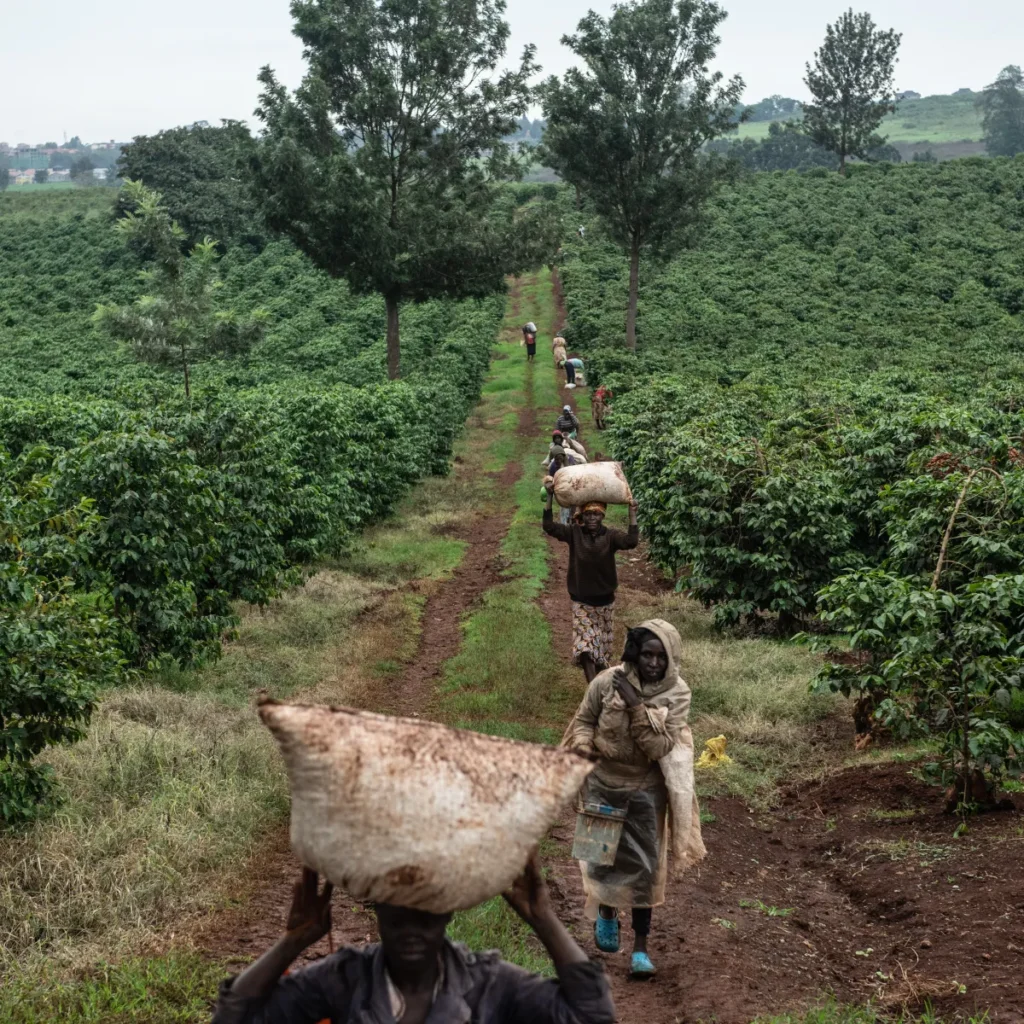Sustainable Coffee Farming: How African Growers Are Leading the Way

Sustainable Coffee Farming: How African Growers Are Leading the Way
In the face of climate change, environmental degradation, and economic challenges, coffee farmers worldwide are being forced to adapt their practices to ensure the long-term viability of their crops and livelihoods. Across Africa’s coffee-growing regions, from Ethiopia’s ancient coffee forests to Kenya’s volcanic highlands, farmers are pioneering innovative approaches to sustainability that are transforming the industry. These methods not only help preserve the environment but also improve coffee quality and enhance the economic resilience of farming communities.
This article explores how African coffee farmers are leading the way in sustainable farming practices, from traditional shade-grown methods to cutting-edge water conservation techniques. Their experiences offer valuable lessons for coffee production worldwide and provide a compelling case for supporting sustainably grown African coffee.
Traditional Wisdom: Africa’s Heritage of Sustainable Coffee Cultivation
Long before “sustainability” became a global buzzword, many African coffee-growing communities practiced environmentally sound cultivation methods passed down through generations. These traditional approaches, born of necessity and deep ecological knowledge, are now being recognized for their relevance to modern sustainability challenges.
Ethiopia’s Forest Coffee Systems
In Ethiopia, the birthplace of coffee, traditional forest coffee systems represent one of the world’s oldest sustainable agricultural practices. In regions like Kaffa and Yayu, wild coffee still grows as an understory plant beneath the canopy of native forest trees. Local communities have harvested these naturally occurring coffee plants for centuries, developing management systems that maintain forest integrity while providing economic benefits.
These forest coffee systems function as complex agroecosystems with multiple layers of vegetation. Tall native trees provide shade and habitat for wildlife, while the coffee plants thrive in the dappled light below. This approach requires minimal external inputs—no synthetic fertilizers or pesticides—as the forest’s natural cycles maintain soil fertility and pest balance.
The ecological benefits of Ethiopia’s forest coffee systems are substantial:
•Biodiversity conservation: These forests harbor exceptional plant and animal diversity, including many endemic species found nowhere else on Earth.
•Carbon sequestration: The multi-layered vegetation structure stores significant amounts of carbon, helping mitigate climate change.
•Watershed protection: Forest cover prevents erosion and regulates water flow, maintaining clean water sources for downstream communities.
•Genetic resource preservation: Ethiopia’s forest coffee represents the world’s largest reservoir of coffee genetic diversity, with thousands of uncatalogued varieties that may hold traits vital for the crop’s future resilience.
While these traditional systems face pressure from population growth and land-use change, their continued existence demonstrates the viability of truly sustainable coffee production. Conservation efforts, including UNESCO Biosphere Reserve designation for areas like Yayu, aim to preserve these living examples of harmony between coffee production and forest conservation.
Traditional Intercropping Systems
Across East Africa, smallholder farmers have long practiced intercropping—growing coffee alongside other crops in the same field. This approach, born of practical necessity for food security, delivers multiple sustainability benefits:
•Diversified income streams: When coffee prices fluctuate, income from other crops provides economic stability.
•Enhanced soil health: Different plants extract and return different nutrients to the soil, reducing the need for external inputs.
•Natural pest management: Diverse plantings disrupt pest cycles and attract beneficial insects, reducing reliance on pesticides.
•Maximized land productivity: Intercropping makes efficient use of limited land, important for smallholders with small plots.
In Uganda’s Rwenzori region, farmers traditionally grow coffee alongside bananas, which provide shade for young coffee plants and food for the household. Beans and other legumes are often planted between coffee rows, fixing nitrogen in the soil and providing additional food crops.
In Kenya’s central highlands, smallholders have developed complex multi-story systems where tall trees like grevillea provide the uppermost canopy, coffee forms the middle layer, and food crops like sweet potatoes occupy the ground level. This vertical stratification maximizes productivity while mimicking natural forest structure.
These traditional intercropping approaches are now being studied and refined by agricultural researchers, who recognize their relevance to modern challenges of climate resilience and food security.
Modern Eco-Friendly Innovations
Building on traditional knowledge, African coffee farmers are adopting and adapting modern sustainable farming innovations. These approaches combine scientific understanding with practical application, often blending traditional wisdom with new technologies.
Organic Farming Practices
Organic coffee production has gained significant traction across Africa, with certified organic operations in Ethiopia, Uganda, Tanzania, and beyond. While many smallholder farmers have always grown coffee without synthetic inputs (often due to cost and access limitations), formal organic certification allows them to access premium markets and receive better prices for their beans.
In Uganda, the Bukonzo Joint Cooperative Union in the Rwenzori Mountains has helped thousands of smallholder farmers achieve organic certification. Their approach emphasizes:
•Composting: Converting coffee pulp, animal manure, and other organic materials into nutrient-rich compost that improves soil structure and fertility.
•Natural pest management: Using botanical pesticides derived from local plants like chili peppers and neem, along with cultural practices that disrupt pest cycles.
•Cover cropping: Planting soil-building crops like legumes between coffee rows to prevent erosion, suppress weeds, and fix nitrogen.
•Mulching: Applying organic materials around coffee plants to conserve moisture, suppress weeds, and gradually add nutrients to the soil as they decompose.
The results have been impressive: improved soil health, reduced production costs, and access to premium organic markets that pay higher prices for their coffee.
In Ethiopia’s Sidama region, the Sidama Coffee Farmers Cooperative Union has helped member cooperatives transition to certified organic production. Their approach emphasizes traditional practices that have always been organic in nature but adds modern elements like systematic composting and improved organic pest management techniques.
Innovative Water Conservation
Water scarcity is an increasing challenge in many African coffee regions due to climate change and competing demands. Innovative farmers and cooperatives are implementing water conservation measures that reduce consumption while maintaining or improving coffee quality.
Eco-Pulping Technology
Traditional coffee processing requires significant water—up to 20 liters per kilogram of coffee cherries in some conventional wet mills. Innovative eco-pulpers developed and adopted in countries like Rwanda and Kenya have dramatically reduced this water footprint:
•Mechanical demucilaging: These machines mechanically remove the sticky mucilage layer from coffee beans with minimal water, reducing water usage by up to 90% compared to traditional fermentation methods.
•Water recycling systems: Advanced processing stations recirculate water through filtration systems, allowing the same water to be used multiple times before final disposal.
•Biogas generation: Some facilities capture methane from wastewater through biodigestion, converting a potential pollutant into clean cooking fuel for local communities.
Rwanda’s coffee sector has been particularly progressive in adopting these technologies. Following the country’s 1994 genocide, the rebuilding coffee industry incorporated eco-pulping technology into many new washing stations. Today, Rwanda’s coffee processing facilities are among the most water-efficient in Africa, demonstrating that quality processing can be achieved with minimal environmental impact.
Rainwater Harvesting
In regions with distinct wet and dry seasons, rainwater harvesting has emerged as a crucial sustainability practice. Innovative approaches include:
•Farm-level catchment systems: Simple structures that direct rainwater from roofs and other surfaces into storage tanks for use during dry periods.
•Community-scale reservoirs: Larger water storage facilities that serve multiple farms, often managed by cooperatives.
•Swales and check dams: Landscape features that slow water movement across farms, increasing infiltration and groundwater recharge.
In Kenya’s eastern highlands, the Rumukia Cooperative Society has implemented an integrated water management system that combines rainwater harvesting with precision irrigation. During the rainy season, water is collected in community reservoirs and then distributed through efficient drip irrigation systems during dry periods. This approach has helped farmers maintain production despite increasingly unpredictable rainfall patterns.
Shade-Grown Coffee Benefits
While shade-grown coffee has always been common in parts of Africa, particularly Ethiopia, there’s growing recognition of its multiple benefits across the continent. Modern shade systems are being designed with specific ecological and economic goals in mind:
Biodiversity Enhancement
Strategic shade tree selection can create habitat for birds and beneficial insects that control coffee pests. In Tanzania’s Kilimanjaro region, farmers working with conservation organizations have planted native shade trees that attract insectivorous birds, reducing the need for pesticides to control coffee berry borers.
Research in Ethiopia has documented significantly higher bird diversity in shade coffee systems compared to sun-grown plantations, with corresponding benefits for natural pest control. Some farmers report up to 30% reduction in pest damage when appropriate shade systems are established.
Climate Resilience
Shade trees moderate temperature extremes around coffee plants—a crucial benefit as climate change brings more frequent heat waves and erratic weather. Measurements in shaded versus unshaded coffee plots in Rwanda showed that shade reduced maximum temperatures by 4-6°C during heat waves, keeping coffee plants below stress thresholds.
The cooling effect of shade is particularly important for arabica coffee, which is sensitive to high temperatures. As climate change threatens traditional coffee-growing areas, shade systems offer a practical adaptation strategy that can extend the viability of coffee cultivation in warming regions.
Carbon Sequestration
Coffee farms with diverse shade trees function as carbon sinks, sequestering atmospheric carbon in both trees and soil. In Uganda, the Kibale Forest Coffee Project has developed a carbon credit system where farmers receive payments for maintaining and expanding shade tree coverage on their coffee farms, creating an additional revenue stream while mitigating climate change.
Scientific measurements in these systems have documented carbon sequestration rates of 10-15 metric tons of CO₂ equivalent per hectare per year—significant figures that demonstrate coffee farms’ potential contribution to climate change mitigation when properly managed.
Quality Improvements
Beyond environmental benefits, shade-grown coffee often develops more complex flavor profiles due to slower maturation of coffee cherries. Cupping results from controlled studies in Rwanda showed that shade-grown samples scored consistently higher on flavor complexity and sweetness compared to sun-grown counterparts from the same varieties and elevations.
This quality advantage translates to market benefits: shade-grown coffees from Ethiopia’s Harrar region command premium prices in specialty markets, with some lots selling for 30-50% more than comparable sun-grown coffees.
Community-Based Sustainability Initiatives
Some of the most successful sustainable coffee initiatives in Africa are community-led efforts that address environmental, social, and economic dimensions simultaneously. These holistic approaches recognize that true sustainability must benefit people as well as the environment.
Cooperative-Led Environmental Programs
Coffee cooperatives across Africa have become powerful vehicles for implementing sustainability practices at scale. By pooling resources and knowledge, smallholder farmers can achieve what would be impossible individually.
Tanzania: KNCU’s Integrated Approach
The Kilimanjaro Native Cooperative Union (KNCU) in Tanzania, Africa’s oldest coffee cooperative, has developed a comprehensive sustainability program that includes:
•Community nurseries: Centralized facilities that produce coffee seedlings and native shade tree saplings for distribution to member farmers.
•Farmer field schools: Practical education centers where farmers learn and practice organic cultivation methods, composting, and integrated pest management.

